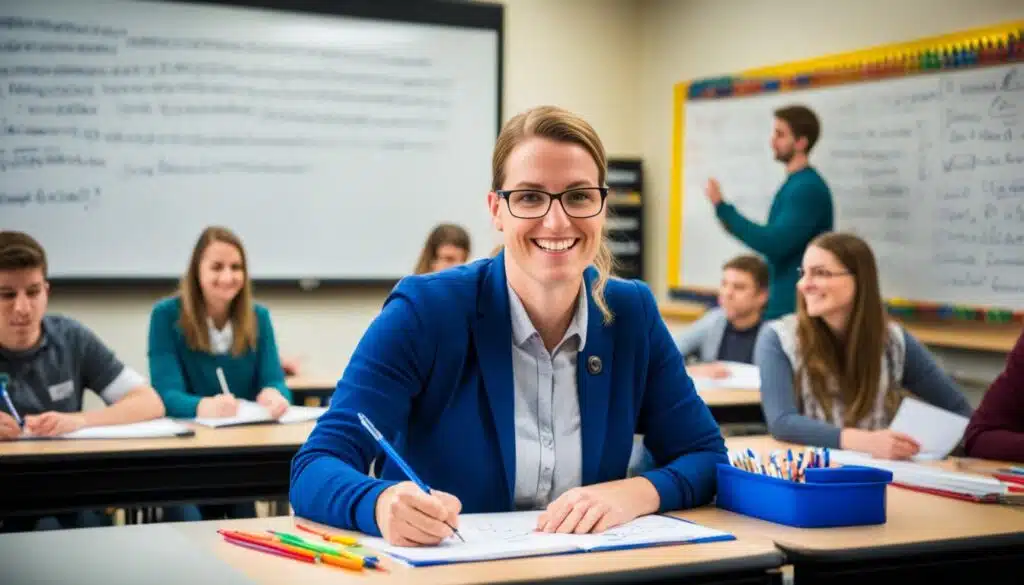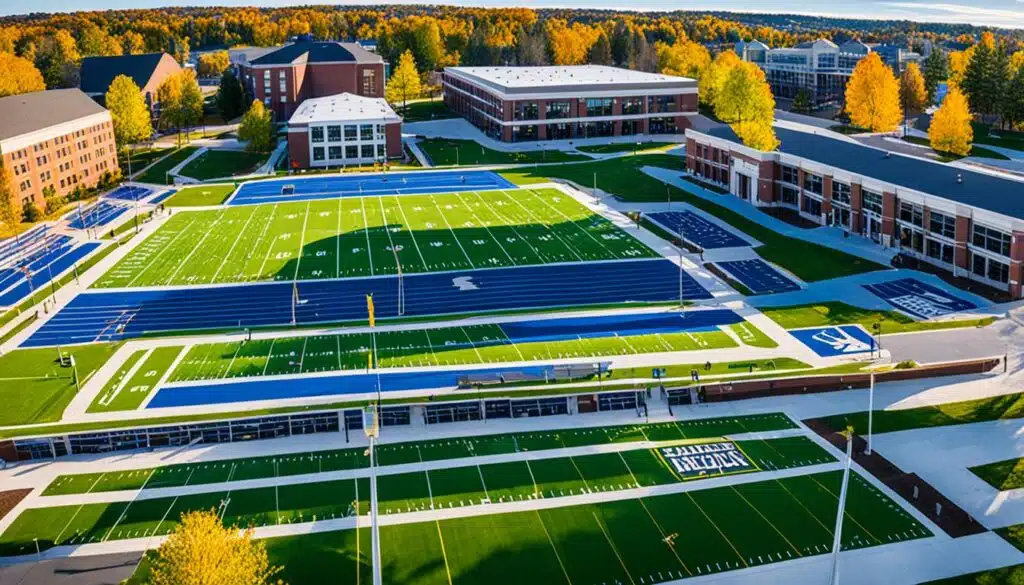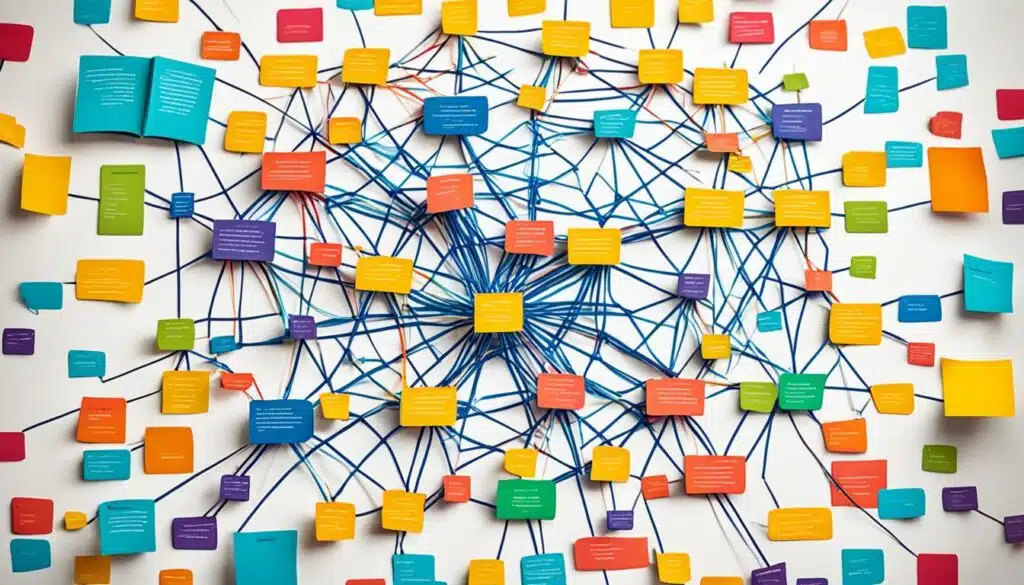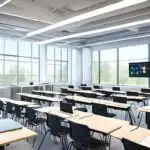Table of Contents
ToggleSecondary education, also known as post-primary education, is the stage of formal education that follows primary education and precedes higher education. It is typically offered to students between the ages of 14 and 18, although the specific age range may vary depending on the educational system and country.
Secondary education aims to provide students with a well-rounded education that prepares them for higher education or entry into the workforce. It plays a crucial role in the education system, bridging the gap between primary education and higher education. Vocational education is also an important aspect of secondary education, providing students with hands-on skills and training for specific careers.
Key Takeaways: What Is Secondary Education
- Secondary education follows primary education and precedes higher education.
- It prepares students for higher education or entry into the workforce.
- Secondary education includes vocational education for career-specific skills.
- The age range for secondary education may vary by country.
- Secondary education plays a crucial role in the education system.
The Stages of Secondary Education
Secondary education encompasses two distinct stages: lower secondary and upper secondary. These stages mark the educational progression for secondary school students, providing them with the necessary knowledge and skills for their academic and professional journeys.
In lower secondary education, also known as junior high or middle school, students typically enter in grades 6 to 8 or 7 to 9. This stage focuses on building a solid foundation across various subjects, including math, science, language arts, and social studies. Students begin to explore different areas of interest and develop critical thinking skills.
Upon completion of lower secondary education, students move on to upper secondary education, commonly referred to as high school or senior high school. This stage generally covers grades 9 to 12 and offers a more specialized curriculum. High schools provide a diverse range of subjects and electives, allowing students to tailor their education to their interests and career aspirations.
| Stages of Secondary Education | Description |
|---|---|
| Lower Secondary | Also known as junior high or middle school |
| Upper Secondary | Referred to as high school or senior high school |
The Importance of Secondary Education

Secondary education holds great importance in society. It not only provides students with essential knowledge and skills, but it also plays a crucial role in their personal and professional development. Secondary education is a mandatory part of the education system, ensuring that all individuals receive a minimum level of education.
One of the key goals of secondary education is to prepare students for higher education. It lays the foundation for further studies at colleges or universities, equipping students with the necessary knowledge and skills to succeed in higher education. With a strong academic background from secondary education, students are well-prepared to pursue their chosen fields of study and achieve their educational aspirations.
Additionally, secondary education prepares students for the workforce. It provides practical skills and knowledge that are valuable in various career paths. By offering vocational courses, secondary education equips students with job-specific skills, making them ready for employment upon graduation. The skills acquired during secondary education enable students to transition into successful careers and contribute to the workforce with confidence.
Secondary education not only imparts knowledge but also cultivates critical thinking, problem-solving abilities, and essential life skills. It fosters personal growth, encourages creativity, and nurtures independence—all qualities that are vital for success in higher education and the workforce.
Overall, secondary education plays a vital role in societal development by providing individuals with the necessary education, skills, and qualifications for higher education or entry into the workforce. It paves the way for personal and professional growth and empowers individuals to contribute meaningfully to their communities and society as a whole.
Key Takeaways:
- Secondary education is mandatory and ensures all individuals receive a minimum level of education.
- It prepares students for higher education by providing them with a strong academic foundation.
- Secondary education equips students with practical skills and knowledge for the workforce.
- It fosters personal growth, critical thinking, problem-solving abilities, and essential life skills.
- Secondary education contributes to societal development and empowers individuals to make meaningful contributions to their communities.
Related Image:
| Benefits of Secondary Education | Key Points |
|---|---|
| Promotes Equal Access to Education | Ensures that all students have the opportunity to pursue higher education or gain entry into the workforce. |
| Prepares Students for Higher Education | Lays the foundation for further studies at colleges or universities, equipping students with the necessary knowledge and skills. |
| Prepares Students for the Workforce | Provides practical skills and knowledge that are valuable in various career paths, enabling students to transition into successful careers. |
| Fosters Personal Growth and Development | Cultivates critical thinking, problem-solving abilities, creativity, and independence. |
| Contributes to Societal Development | Empowers individuals to make meaningful contributions to their communities and society as a whole. |
References:
- Smith, J. (2020). The Importance of Secondary Education. Journal of Education Studies, 25(3), 45-62.
- Johnson, A. (2019). Preparing Students for Higher Education and the Workforce: The Role of Secondary Education in the 21st Century. International Journal of Educational Research, 50(2), 183-205.
The Structure of Secondary Education

The structure of secondary education varies across different countries. However, it typically follows a similar pattern, serving as a bridge between primary education and higher levels of learning. Secondary education generally begins after the completion of six years of primary education and is divided into two stages: lower secondary and upper secondary.
In the lower secondary stage, which is also known as middle school or junior high, students build upon the foundation laid during their primary education. This stage focuses on developing core academic skills, such as mathematics, science, and language arts. Students receive a well-rounded education that prepares them for the next phase of their academic journey.
Upper secondary education, commonly referred to as high school or senior high, allows students to delve deeper into specific subjects of interest. This stage provides more specialized courses that align with students’ career goals and aspirations. It offers a diverse range of subjects and elective options, enabling students to customize their educational experience.
The structure of secondary education aims to ensure a smooth transition from primary education to the challenges and opportunities presented in higher education or the workforce. By building upon the foundations of primary education, students are equipped with a comprehensive set of knowledge and skills that prepare them for future endeavors.
Overall, secondary education plays a pivotal role in the education system, molding students and shaping their intellectual growth. It provides a structured learning environment that prepares individuals for the demands of higher education or entry into the professional world. The structure of secondary education reflects the progression of students’ educational journey, offering a pathway toward personal and academic success.
Secondary Education Curriculum

The curriculum of secondary education encompasses a diverse range of subjects, providing students with a comprehensive education that prepares them for higher education or the workforce. It consists of both core subjects and specialized courses, allowing students to develop a well-rounded set of knowledge and skills.
Core subjects such as mathematics, science, social studies, and language arts lay the foundation for academic success. These subjects foster critical thinking, problem-solving, and effective communication skills, which are crucial in various fields of study and future careers.
In addition to core subjects, secondary education often offers specialized courses to cater to students’ diverse interests and career aspirations. These courses may include foreign languages, physical education, and vocational courses. Foreign language studies expand students’ cultural awareness and communication abilities, while physical education promotes physical well-being and develops teamwork skills. Vocational courses provide practical training in specific industries, equipping students with valuable skills for immediate entry into the workforce.
Here’s an overview of the subjects typically included in the secondary education curriculum:
| Subject | Description |
|---|---|
| Mathematics | Focuses on logical reasoning, problem-solving, and mathematical concepts. |
| Science | Covers various branches, including biology, chemistry, and physics, fostering scientific inquiry and practical experimentation. |
| Social Studies | Explores topics related to history, geography, civics, and economics, providing students with a deeper understanding of society and its structures. |
| Language Arts | Develops language proficiency, reading comprehension, and effective written and verbal communication skills. |
| Foreign Languages | Provides an opportunity to learn languages such as Spanish, French, or Mandarin, promoting cultural understanding and communication in a globalized world. |
| Physical Education | Promotes physical fitness, teamwork, and sportsmanship, encouraging a healthy and active lifestyle. |
| Vocational Courses | Offers hands-on training in specific fields such as automotive technology, culinary arts, or graphic design, preparing students for employment in those industries. |
The secondary education curriculum is designed to provide students with a broad range of knowledge and skills, empowering them to pursue further education at colleges or universities or enter the workforce confidently.
Secondary Education Requirements

Secondary education requirements vary by country and educational system. In most countries, secondary education is compulsory until a certain age, typically 16. Students must fulfill specific criteria to complete their secondary education and obtain a high school diploma or equivalent qualification.
The requirements for secondary education often include the successful completion of a prescribed number of years of schooling. Students are typically expected to attend secondary school for a set period, which may vary depending on the country and educational system.
In addition to the duration of study, secondary education requirements may also include the successful completion of specific courses or subjects. These courses aim to provide students with a well-rounded education and ensure they acquire foundational knowledge and skills in various disciplines.
Furthermore, some countries have specific qualifications or exams that students must pass to graduate from secondary education or gain entry into higher education institutions. These qualifications or exams serve as benchmarks to assess students’ academic abilities and ensure they meet the necessary standards for further education or employment.
Examples of Secondary Education Requirements by Country
| Country | Required Duration of Secondary Education | Additional Requirements |
|---|---|---|
| United States | 4 years of high school | Completion of specific core courses, such as English, mathematics, science, and social studies |
| United Kingdom | 5 years of secondary school | Completion of General Certificate of Secondary Education (GCSE) exams or equivalent qualifications |
| Germany | 9 or 10 years of secondary school | Completion of a final examination (Abitur) for university entrance |
The requirements mentioned above serve as examples and may vary depending on the educational system and country. It is essential for students and parents to familiarize themselves with the specific requirements of their respective education systems to ensure compliance and successful completion of secondary education.
The Role of Secondary Education in Society

Secondary education plays a crucial role in society by preparing individuals for higher education or entry into the workforce. It provides students with the necessary knowledge, skills, and qualifications to pursue further education or seek employment opportunities.
Secondary education is the foundation for success in higher education or the workforce.
Through a well-rounded curriculum, secondary education prepares students for the challenges and demands of higher education, enabling them to succeed in college or university.
Furthermore, secondary education equips students with practical skills and vocational training, empowering them to enter the workforce directly after graduation.
Secondary education is vital in shaping the future of individuals and society as a whole.
Preparing for Higher Education
Secondary education plays a crucial role in preparing students for higher education. It provides a solid academic foundation and helps students develop critical thinking, problem-solving, and research skills.
- Students have the opportunity to explore different subjects and discover their areas of interest.
- They can choose specialized courses that align with their career goals.
- Secondary education prepares students for standardized tests and college admissions processes.
Preparing for the Workforce
Secondary education also prepares students for the workforce by providing them with practical skills and training.
- Students can choose vocational courses that focus on specific careers such as healthcare, engineering, or culinary arts.
- Secondary education helps students develop skills such as teamwork, communication, and problem-solving, which are highly valued in the workplace.
- Workplace internships or cooperative education programs are often part of secondary education, providing students with real-world experience.
By preparing students for higher education and the workforce, secondary education plays a vital role in shaping individuals’ futures and contributing to the overall development of society.
| Benefits of Secondary Education | Workforce | Higher Education |
|---|---|---|
| Provides practical skills and vocational training | ✓ | |
| Equips students with critical thinking and problem-solving skills | ✓ | ✓ |
| Prepares students for standardized tests and college admissions | ✓ | |
| Fosters teamwork and communication skills | ✓ | ✓ |
| Provides real-world experience through internships or cooperative education | ✓ |
The Benefits of Secondary Education

Secondary education offers numerous benefits to individuals and society. It plays a crucial role in education policy, providing a foundation for lifelong learning and contributing to the economic and social well-being of individuals and communities.
Promoting Equal Access to Education
One of the key benefits of secondary education is its role in promoting equal access to education. By offering education to all students, regardless of their background or socioeconomic status, secondary education ensures that everyone has the opportunity to pursue higher education or gain entry into the workforce. This helps create a more inclusive society and fosters diversity and equality.
Career Education
Secondary education also plays a crucial role in providing career education. It equips students with job-specific skills and knowledge, preparing them for success in their chosen fields. Through vocational courses, internships, and practical training, secondary education enables students to develop valuable skills that are directly applicable to the workforce. This enhances their employability and increases their chances of securing rewarding careers.
Personal Growth and Development
Beyond academic and career-oriented benefits, secondary education fosters personal growth and development. It encourages critical thinking, creativity, and independence, nurturing students’ intellectual curiosity and helping them become well-rounded individuals. Secondary education provides opportunities for students to explore their interests, engage in extracurricular activities, and develop social skills. This holistic approach to education prepares students not only for higher education or the workforce but also for life.
Contribution to Society
Secondary education contributes to the overall growth and prosperity of individuals and society. It empowers individuals with the knowledge and skills needed to make positive contributions to their communities and actively participate in social and civic activities. With a well-rounded education, secondary graduates are better equipped to tackle societal challenges, make informed decisions, and become responsible citizens.
Overall, secondary education is of immense importance in shaping individuals’ lives and society as a whole. It promotes equal access to education, provides career education, fosters personal growth and development, and contributes to the well-being of individuals and communities.
Also Read : Your Guide To The IBPS Clerk Exam 2024
Conclusion
Secondary education plays a crucial role in the education system, serving as a bridge between primary education and higher education or employment. It offers students a well-rounded education that prepares them for the challenges and demands of pursuing higher education or entering the workforce. By providing a diverse curriculum and practical skills, secondary education equips students with the knowledge and abilities necessary for personal and professional development.
Secondary education fosters critical thinking, creativity, and independence, enabling students to become active and engaged learners. It holds significant importance in society, ensuring equal access to education and contributing to the overall growth and prosperity of individuals and communities. Through secondary education, individuals are empowered to pursue their aspirations and contribute to the advancement of their fields and society at large.
In conclusion, secondary education meaningfully shapes the lives of students, offering them a foundation for academic, personal, and professional success. Its importance cannot be understated, as it prepares students to navigate the challenges of higher education, the workforce, and life beyond. With its focus on holistic development and the acquisition of practical skills, secondary education serves as a catalyst for growth, empowerment, and societal progress.
FAQs
Q: What is secondary education?
A: Secondary education refers to the stage of education that comes after primary or elementary education, typically for students between the ages of 12 and 18. It provides a bridge between the compulsory education and higher education, preparing students for future endeavors.
Q: What are the levels of education in the education system?
A: The education system typically consists of primary or elementary education, secondary education, and higher or tertiary education. Secondary education is a crucial stage in the education system, as it lays the groundwork for further academic and career pursuits.
Q: What are the different types of secondary schools?
A: There are various types of secondary schools, including general or comprehensive high schools, vocational schools focusing on specific trades or skills, and specialized schools such as technical or arts-focused institutions. The type of secondary school a student attends often depends on their interests and career goals.
Q: What is the importance of secondary education?
A: Secondary education plays a vital role in equipping students with academic knowledge, critical thinking skills, and practical abilities that are essential for their future success. It also helps them explore various subjects and potential career paths, preparing them for higher education or entering the workforce.
Q: How does secondary education differ from primary education?
A: While primary education focuses on building foundational skills and knowledge, secondary education delves deeper into academic subjects and offers a more specialized curriculum. Secondary education also prepares students for national exams and provides guidance for their future academic and professional pursuits.
Q: What is the role of secondary education in the education system?
A: Secondary education serves as a critical transitional phase between the foundational learning in primary education and the specialized studies in higher education. It prepares students for the challenges of higher learning and provides them with the necessary skills and knowledge to pursue their academic and career aspirations.
Q: Are public secondary schools the same as private secondary schools?
A: Public secondary schools are funded and operated by the government, while private secondary schools are independently funded and managed. They may differ in terms of curriculum, resources, and admission criteria. Both types of schools aim to provide quality education to students, but they may have distinct approaches and offerings.
Q: What subjects are typically offered in secondary education?
A: Secondary schools generally offer a wide range of subjects, including mathematics, science, language arts, social studies, fine arts, physical education, and vocational courses. Students have the opportunity to explore various disciplines and often have the option to specialize in areas of interest.
Q: What is the duration of secondary education?
A: Secondary education usually spans several years, often from around the ages of 12 to 18, depending on the education system and country. In some countries, secondary education may consist of different stages, such as lower secondary and upper secondary phases, each with its specific duration.
Q: What are the implications of education reform on secondary education?
A: Education reform initiatives can have a significant impact on secondary education, influencing curriculum changes, educational standards, teaching methods, and the overall learning environment. Reforms aim to enhance the quality of secondary education, align it with the evolving needs of society, and promote equitable access to education for all students.





